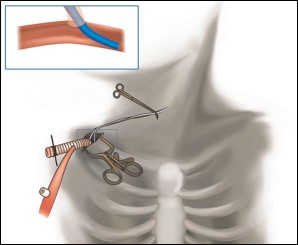ALERT!
This site is not optimized for Internet Explorer 8 (or older).
Please upgrade to a newer version of Internet Explorer or use an alternate browser such as Chrome or Firefox.
Through the Graft Into the Artery: Evolution of the Technique of Right Axillary Cannulation
Calcaterra D, Wherley EM, Ajouz H, Dyal M. Through the Graft Into the Artery: Evolution of the Technique of Right Axillary Cannulation. September 2022. doi:10.25373/ctsnet.21155785.
Right axillary artery cannulation has gained consensus in recent years as one of the mainstays of surgical treatment of type A aortic dissections (1).
This technique is routinely used in the treatment of type A dissections, aortic arch aneurysms, aneurysms of the ascending aorta extending to the proximity of the innominate artery takeoff, and any situations where central cannulation of the aorta could be dangerous, such as cases of porcelain aorta or presence of intramural thrombus.
In a 2011 video by the same author, the details of the surgical approach to the right axillary artery with exposure of the vessel in the deltoid-pectoral groove were described. This video showed the connection of the cardio-pulmonary bypass machine inflow line directly to an 8 mm Dacron graft, sewn to the artery on an end-to-side fashion (2).
The technique has been modified over the years, and now includes inserting an inflow cannula using the Seldinger technique through the side of the Dacron graft as shown in the figure below and the accompanying video.

‘Through-the-graft-into-the-artery’ axillary cannulation technique (1)
This simple technical modification allows direct and unobstructed blood flow into the axillary artery, remarkably improves arterial inflow by reducing cardiopulmonary bypass flow resistance, and removes the risk of blood overflow to the right upper extremity (which could cause significant tissue swelling). In addition, it resolves the occurrence of bleeding at the cannulation site during the time of cardiopulmonary bypass, which is typically experienced when the inflow line is directly connected to the Dacron graft.
This technique finds useful application as inflow for venoarterial ECMO and for placement of Impella (Abiomed) left ventricular extracorporeal hemodynamic support.
The technique is shown in the video below.
References
- Calcaterra D. Treatment of type A dissection: Searching for the Holy Grail. J Card Surg. 2021 Jun;36(6):1840-1842. doi: 10.1111/jocs.15458. Epub 2021 Mar 11. PMID: 33709445
- Calcaterra D, Hashimi AS, Fernandez J, Iannettoni M. 2011. https://www.ctsnet.org/article/right-axillary-artery-cannulation-approac... deltoid-pectoral-groove-using-a-aside-branch. Ctsnet.org
Disclaimer
The information and views presented on CTSNet.org represent the views of the authors and contributors of the material and not of CTSNet. Please review our full disclaimer page here.




